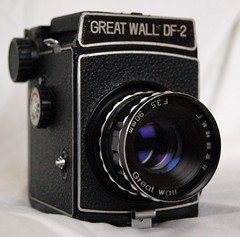Difference between revisions of "Great Wall DF"
Rebollo fr (talk | contribs) m (internal links, image rights tags) |
Rebollo fr (talk | contribs) m (internal link) |
||
| Line 22: | Line 22: | ||
The model "DF-2" is the most common type, of the perhaps 5 variations made. | The model "DF-2" is the most common type, of the perhaps 5 variations made. | ||
| − | The camera was made in the 1970s–80s. Its design was largely derived from the German | + | The camera was made in the 1970s–80s. Its design was largely derived from the German [[Pilot 6]] camera made by KW. |
The lens is a 90mm front-cell focusing Tessar type. Unlike most Chinese "basic" cameras which use a Cooke Triplet type, the Great Wall has a true Tessar formula lens. The front cell focusing barrel focuses from 1 metre. The lens mount is removable, and uses the standard [[Leica screw lenses|Leica 39mm screw thread]]. No other lenses were known to have been made for this camera, and because of the shutter design, it was perhaps also impossible to design others which would fit and work satisfactorily. The removable lens option is probably to allow the photographer to use the lens on an enlarger to make prints from the Great Wall negatives. | The lens is a 90mm front-cell focusing Tessar type. Unlike most Chinese "basic" cameras which use a Cooke Triplet type, the Great Wall has a true Tessar formula lens. The front cell focusing barrel focuses from 1 metre. The lens mount is removable, and uses the standard [[Leica screw lenses|Leica 39mm screw thread]]. No other lenses were known to have been made for this camera, and because of the shutter design, it was perhaps also impossible to design others which would fit and work satisfactorily. The removable lens option is probably to allow the photographer to use the lens on an enlarger to make prints from the Great Wall negatives. | ||
Revision as of 15:54, 15 September 2010

|
| Great Wall DF-2, by Hartacnut. (Image rights) |

|
| DF-2 finder screen, by studio CvH. (Image rights) |

|
| Great Wall DF-2, by Boxy Brown's Bling. (Image rights) |
The Great Wall DF cameras are a Chinese series of medium format SLRs made by Beijing Camera Factory.
The model "DF-2" is the most common type, of the perhaps 5 variations made.
The camera was made in the 1970s–80s. Its design was largely derived from the German Pilot 6 camera made by KW.
The lens is a 90mm front-cell focusing Tessar type. Unlike most Chinese "basic" cameras which use a Cooke Triplet type, the Great Wall has a true Tessar formula lens. The front cell focusing barrel focuses from 1 metre. The lens mount is removable, and uses the standard Leica 39mm screw thread. No other lenses were known to have been made for this camera, and because of the shutter design, it was perhaps also impossible to design others which would fit and work satisfactorily. The removable lens option is probably to allow the photographer to use the lens on an enlarger to make prints from the Great Wall negatives.
The Great Wall shutter is of the guillotine/sector shutter type — neither focal plane nor leaf. The same type of shutter found and used in the original Pilot and the German-made Exa (scaled down Exakta) 35mm SLR. The viewing mirror is part of the shutter. In viewing/focusing position, it blocks the lens path and prevents exposure. When the shutter is tripped, the mirror swings up, unblocking the light path from the lens. Then follow another sector in the form of a curve shield to curtail the exposure, once the ordained timing is done. The second shutter sector moves up from 1/30 to 1/200 second after the mirror swings upwards, depending on the shutter speed selected. The shutter, for some reason, causes some vignetting at the upper or lower parts of the frame. This is the reason why a square (barely 6×6cm) mask is provided to mask off the fuzzy frame edges.
The shutter is also notorious for not opening during exposure on occasion, particularly at the 1/200s setting.
The film is advanced by knob, and positioned by observing the frame numbers on the film paper backing through a red (sometimes green) frame window at the back. There are two windows, one for square 6×6 (12 exposures) and another for rectangular 6×4.5 (for 16 exposures), for this purpose. Both windows are shielded by metal blind lids. When the lids are drawn, both windows open, so it is necessary to remember what format (12 or 16 exposures) is being used, otherwise framing errors will occur. The mask for 6×4.5 exposures is often missing since these were not attached to the camera itself. Masks for 35mm, 127 and 828 roll films were supposed to be available. Making a home-made mask for 6×4.5 can be an easy task.
Links
- DF-3 at heayes.com [1]
- Great Wall on forum Holga [2]